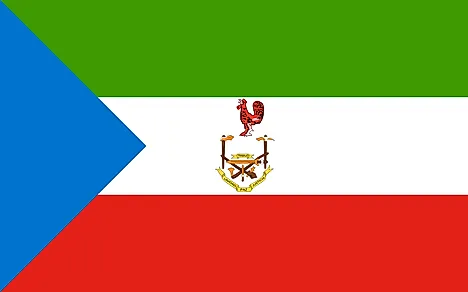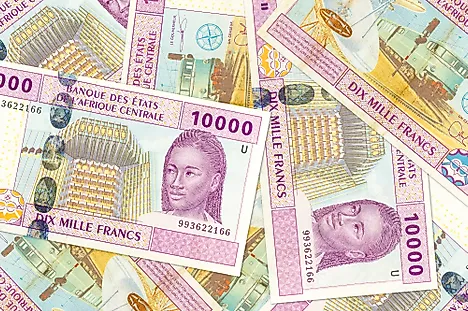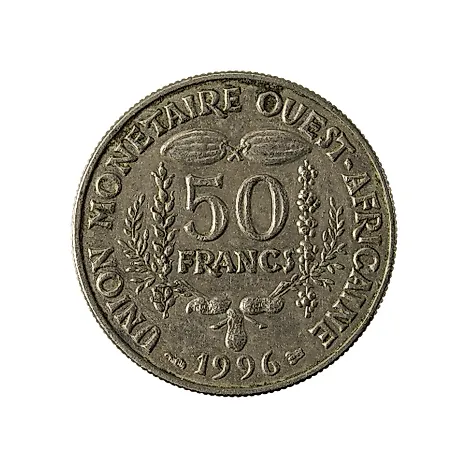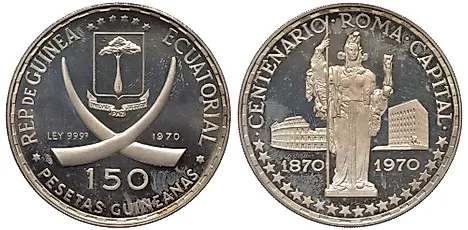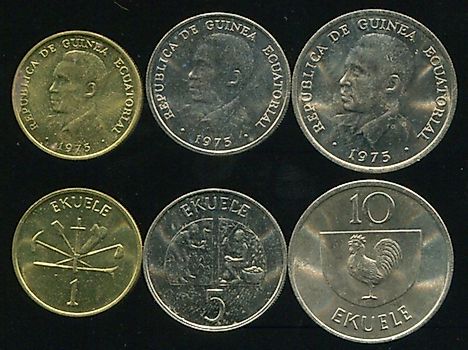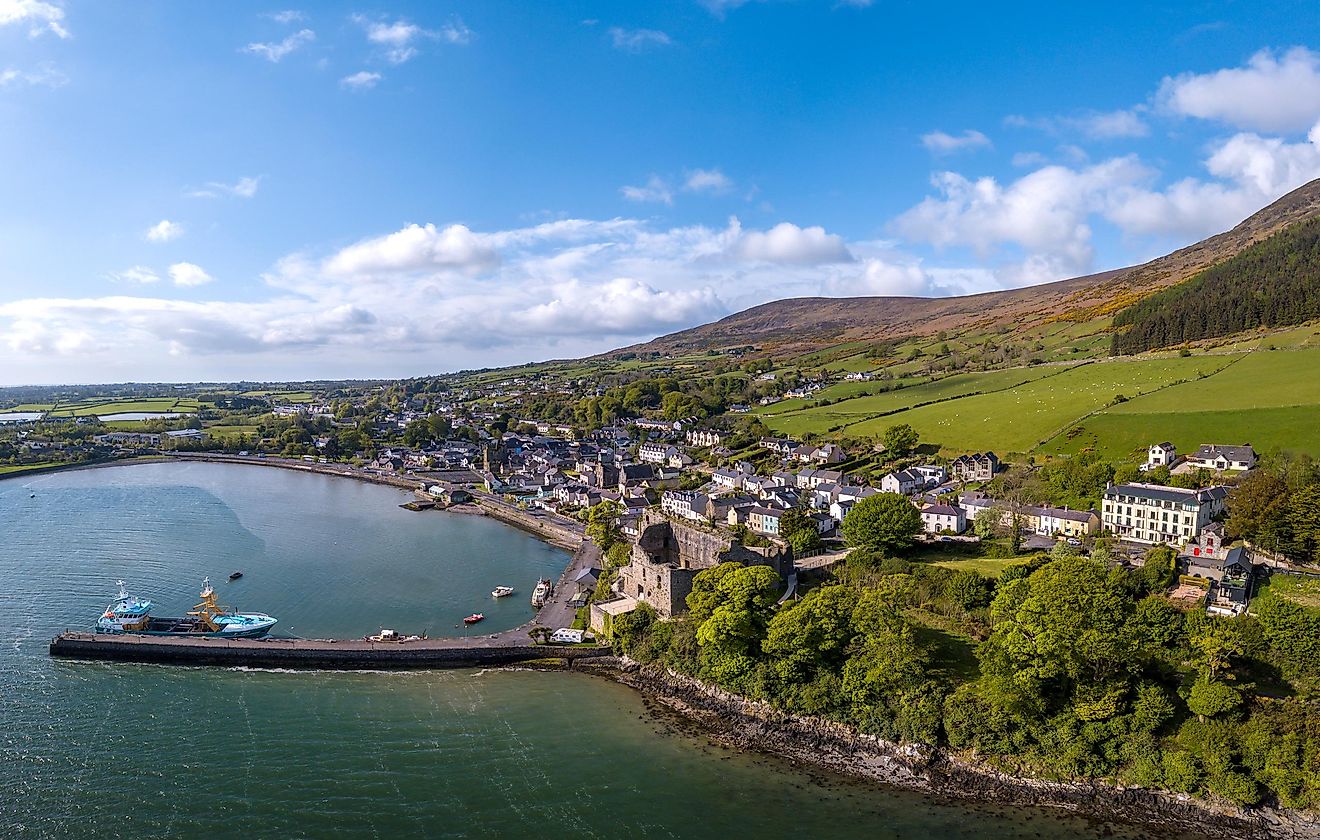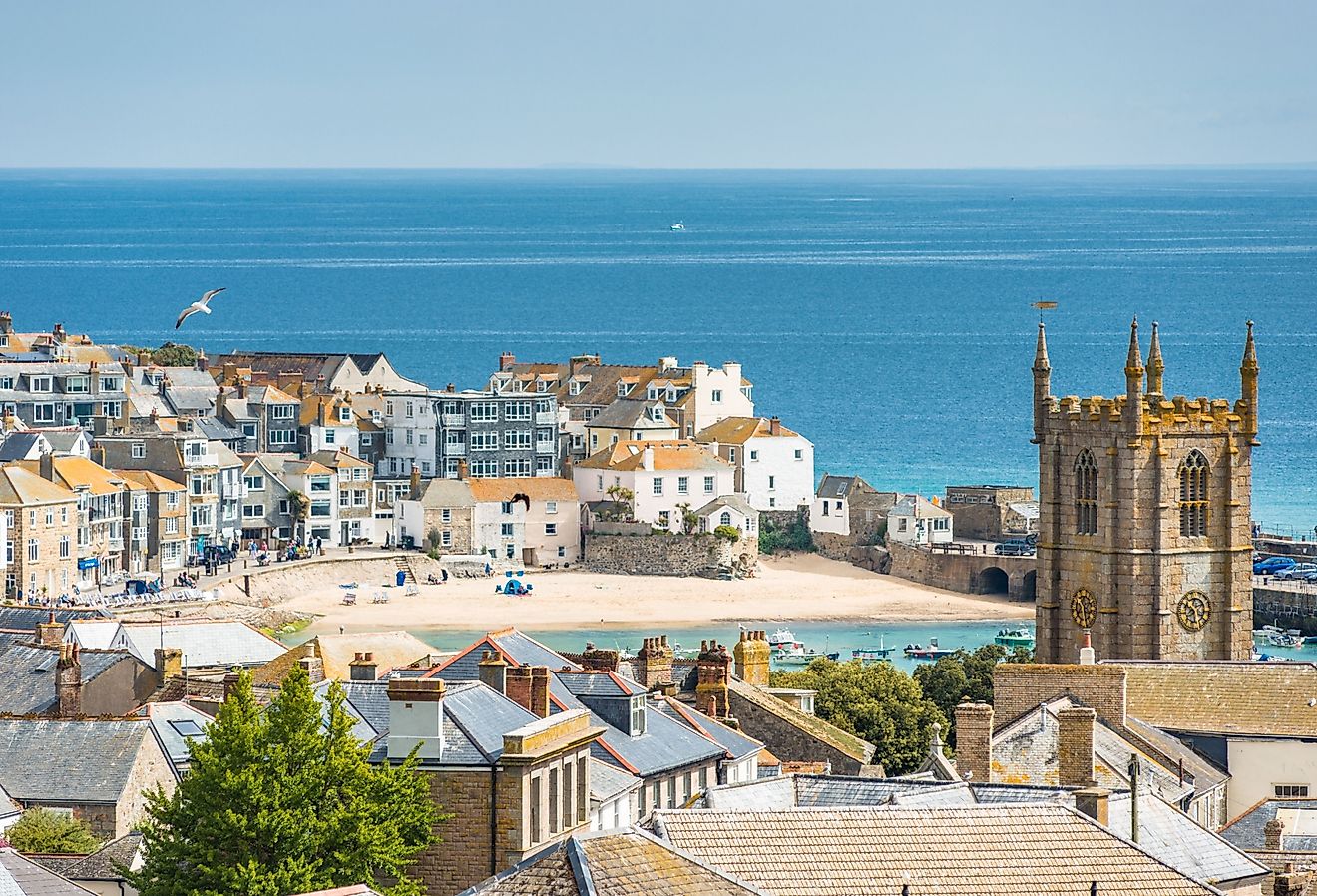Flags, Symbols, & Currencies of Equatorial Guinea
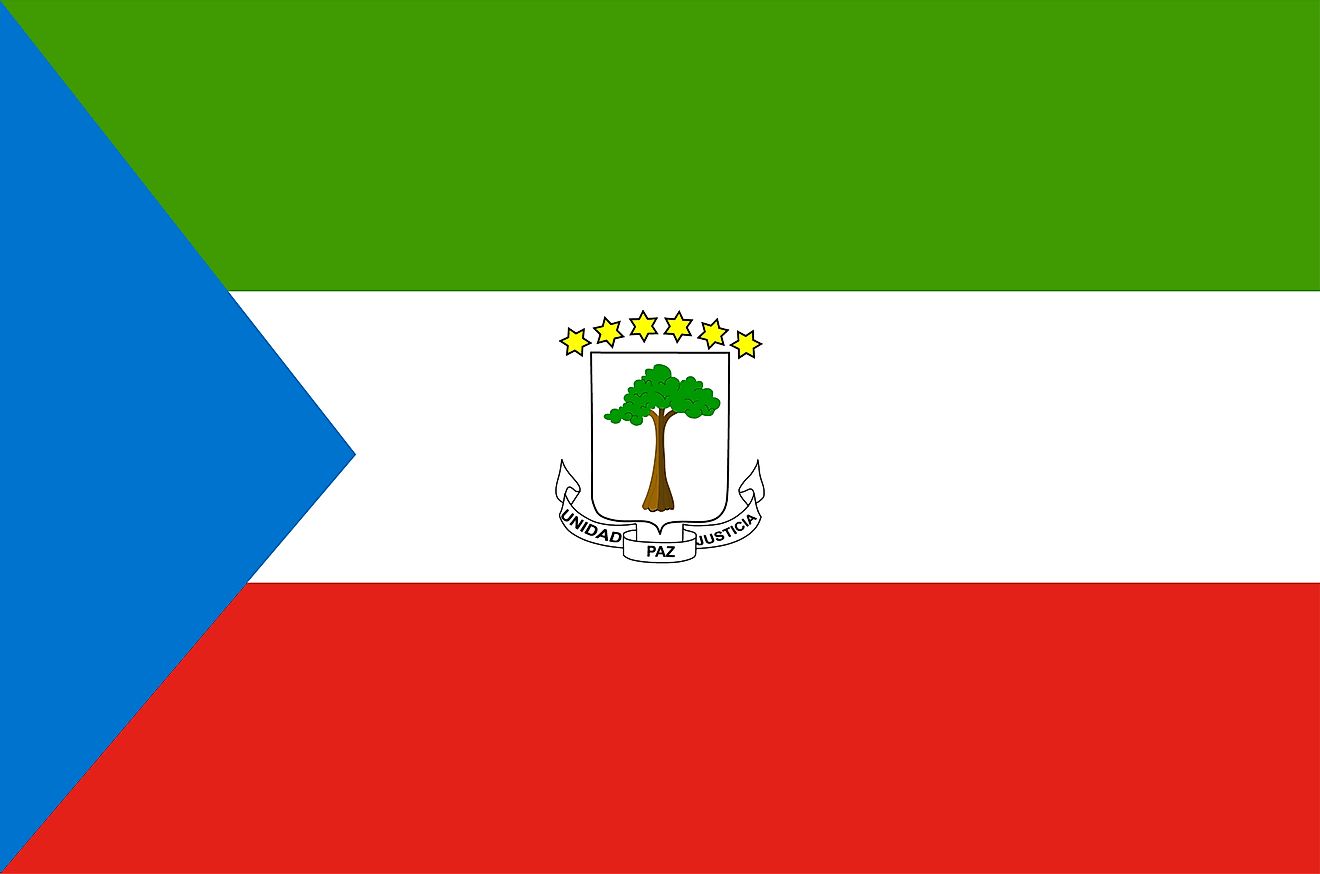
The flag of Equatorial Guinea was officially adopted on October 12, 1968. However, during the reign of Francisco Nguema (1973 to 1979). The flag was slightly modified to include a different coat of arms. When the regime was desposed on August 21, 1979, the flag flown at independence was restored.
The flag of Equatorial Guinea comprises three equal horizontal bands of green (top), white, and red, with a blue isosceles triangle based on the hoist side and the coat of arms centered in the white band. The coat of arms has six yellow six-pointed stars (representing the mainland and five offshore islands) above a gray shield bearing a silk-cotton tree. Below the shield is a scroll with the motto: UNIDAD, PAZ, JUSTICIA (Unity, Peace, Justice).
The green on the flag of Equatorial Guinea symbolizes the jungle and natural resources and blue represents the sea that connects the mainland to the islands. White stands for peace, and red symbolizes the blood shed during the fight for independence
History of the Flag of Equatorial Guinea
Several European colonialists settled in the present-day Equatorial Guinea in different periods of the country's history, including portuguese and Spanish. However, the Spanish were the last colonialist to occupy the area. During the Spanish Guinea era, the Spanish flew the colonial flag throughout the country and neigboring regions. The flag consisted of the red-yellow-red horizontal bands defaced with seal near the hoist side. The flag was used from 1945 until 1968, when Equatorial Guinea attained its independence and adopted the current flag
Symbols of Equatorial Guinea
National Coat of Arms of Equatorial Guinea
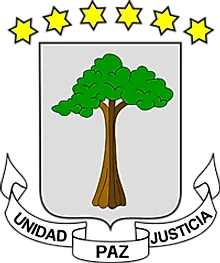
The coat of arms of Equatorial Guinea is composed of a gray shield bearing a silk cotton tree (or the so called God tree). The silk-tree represents the place where the first treaty between the local rulers and Portuguese was signed. Above the shield are six 6-pointed golden stars representing the mainland the five offshore islands. A gray ribbon with the national motto: Unidad, Paz, Justicia ("Unity, Peace, Justice") is displayed below.the shield. Although the arms and the motto were adopted in 1968, they were briefly changed during Francisco Nguema's regime (1972 to 1979). However, it was restored in 1979.
National Anthem
- Anthem Title: Caminemos pisando las sendas de nuestra inmensa felicidad (Let Us Tread the Path of Our Immense Happiness)
- Music composer: Ramiro Sánchez López
- Lyricist: Atanasio Ndongo Miyone
- Date of Adoption: 1968
The national anthem of Equatorial Guinea is titled :Caminemos pisando las sendas de nuestra inmensa felicidad," translated as "Let Us Tread the Path of Our Immense Happiness." The lyrics for the anthem were written by Atanasio Ndongo Miyone, while Ramiro Sánchez López composed the music. The lyrics were influenced by the country's agitation for independence, with the main theme being anti-colonization. The anthem was adopted on October 12, 1968, at independence.
Caminemos pisando las sendas de nuestra inmensa felicidad (Spanish)
Caminemos pisando la senda
De nuestra inmensa felicidad.
En fraternidad, sin separación,
¡Cantemos Libertad!
Tras dos siglos de estar sometidos
Bajo la dominación colonial,
En fraterna unión, sin discriminar,
¡Cantemos Libertad!
Chorus
¡Gritemos Viva, Libre Guinea,
Y defendamos nuestra Libertad.
Cantemos siempre, Libre Guinea,
Y conservemos siempre la unidad.
Y conservemos, Y conservemos
La independencia nacional.
Y conservemos, Y conservemos
La independencia nacional.
Let Us Tread the Path of Our Immense Happiness
Let us walk the path
Of our great happiness.
In brotherhood, without separation,
We sing Freedom!
After two centuries of being subjected
Under colonial rule,
In fraternal union, without discrimination,
We sing Freedom!
Chorus
Let us shout long live free Guinea,
Defend our freedom.
Sing always free Guinea,
And always preserve the unity.
And always we preserve
National independence
And we preserve, we preserve
National independence.
The Currency of Equatorial Guinea is the CFA franc
Equatorial Guinea has had several currencies in the past. However, the current official legal tender is the Central African franc. The Central African Franc replaced Equatorial Guinean Ekwele in 1985.
Equatorial Guinea was the first non-French speaking nation to accede to the Franc Zone. It switched its currency from ekwele to Central African franc. The Central African franc is also used as the legal tender in Cameroon, Chad, Republic of Congo, Central African Republic, and Gabon. The Central African Franc shares a lot of features with the West African franc including its exchange rate to the euro. The two currencies are backed by the Treasury in France. The six nations that use the Central African franc rely on one primary financial institution, the Bank of the Central African States based in Yaoundé, Cameroon. The bank mints and issues the franc to the six member states. The currency has a fixed exchange rate to the Euro where one euro is equivalent 655.95 Central African francs.
Since Equatorial Guinea adopted the Central African Franc, the country had enjoyed stable rates of inflation unlike before when the inflation rate went as high as 40 percent. Business ties with France and other European nations have improved due to the close link between the Central African Franc and the Euro. Furthermore, use of a common currency has increased trade between the Central African Nations.
Limitations of the Central African Franc
The use of the Central African Franc is heavily criticized by some economists. Its fixed status to the Euro is blamed for underdevelopment in the countries where it is used. The currency is also said to be overvalued. It favors importers and discourages exports which are a source of income to the Central African States. Another limitation of the Central African Franc is that the member states have no control over the movement of the currency due to its fixed link to the Euro. The Central African states depend on the monetary policies of the European Central Bank.
Historical Currencies of Equatorial Guinea
Equatorial Guinea was Spanish Colony until October 12, 1968, when it gained independence. During the colonial period, the nation maintained strong trade ties with Spain, Germany, France, and the UK. Equatorial Guinea was a famous trade route for the West African slave trade. The country also exported coffee, cocoa, and timber to European countries. The traders used the Spanish Peseta, introduced to the country by the colonial masters, as a currency for trade. Soon after independence, Equatorial Guinea abandoned the Spanish Peseta and adopted the Equatorial Guinean Peseta. The Equatorial Guinean Peseta bore a close resemblance to the Spanish Peseta. Additionally, its value matched the Spanish Peseta’s value. The currency was in the form of three bank note denominations and four coin denominations. The coins and banknotes had the portrait of Equatorial Guinea’s first president, Francisco Macias Nguema. On August 3rd, 1979, Macias Nguema was dethroned and his portrait removed from the currency. Equatorial Guinea replaced the Peseta with the Guinean Ekwele. The exchange rate for the Peseta to the Ekwele was at par. Ekwele was the official currency of Equatorial Guinea until 1985 when the country joined the Franc Zone.

